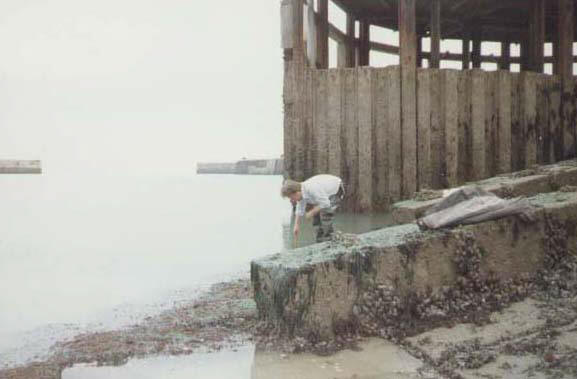
 |
Rockpooling on the British Seashore
Adur
World Oceans Day 2002
Photograph
by Duncan Morrison (Adur District Council)
What is it?
This is the first question that a child is likely to ask. A parent can usually satisfy the curious youngster with general answers of crab, snail (mollusc), prawn, starfish, sea anemone, barnacle, hermit crab, seaweed, fish etc. "What is the fish called daddy?"
Now things are getting decidedly tricky. Over 40 different fish are regularly found between the tides. Any modern natural history book of British wildlife will show coloured drawings, but enthusiasts will need a specialist book. The common fish of the shore are the sandy coloured Gobies that are left behind in shallow pools by the ebbing tide, the Blenny, or Shanny, Lipophrys pholis, a small green fish found under rocks, and small greenish-brown Wrasse that can be netted in pools, probably the Corkwing, Crenilabrus melops. The predatory Bullhead, or Sea Scorpion, Taurulus bubalis, is common in most areas. But there are many other fish that are regularly found including the Rocklings, Butterfish, Pipefish and Clingfish.
Only for accurate biological recording and long term aquarium study is it important to get the exact name right. For a child's education it is really only necessary to put a general name to the animal or plant (flora or fauna).

Hermit Crab, Pagurus bernhardus, with the Calliactis sea anemone on its shell.
What lives where?
What lives where? This is the best thing for the parent to know rather than repeating a list of names.
One feature that may be missed until it is pointed out, is the changing nature of the shore as you move down towards the sea. The extent that the tide will move up the shore will be marked with a strandline of seaweeds and other debris on the shingle and some of the rocky beaches. If this strandline is not present, the limit of the rising tide has to be deduced from the position of the Barnacles and Limpets on the rock. These animals need to immerse themselves in seawater to feed, but can go for days without feeding when the tide does not come up far enough. When the tide goes out the Acorn Barnacle closes its limestone plates, and the Limpet clamps its shell hard down on to the rock to keep in the moisture until the next high tide.
Limpet
and limpet scars on the sandstone at Cullercoats
As you go further down the shore, the type of dominant brown seaweed changes to the Bladder Wrack, Fucus vesiculosus, which is easy to recognise because of the air bladders on the fronds. These keep the seaweed buoyant and nearer to the sun when submerged. This area is known as the Middle Shore Zone. Beadlet Anemones, Actinia equina, will be discovered in the pools with their tentacles expanded or exposed on the rocks and groynes with their tentacles retracted and looking like a blob of jelly.
In the Lower Shore Zone, the seas resemble the sea itself in terms of the vital dissolved oxygen content and other important variables like the sea temperature and salinity. The omnipresent brown seaweed in this zone is the Serrated Wrack, Fucus serratus, which has a saw-like edge to its frond which is easily seen when looked for.
Towards the low tide mark, the small marine life is both more varied and greater in overall numbers. If the pools are big enough the young of larger fish like the Bass, Dicentrarchus labrax, may become trapped, at least in the south and west, and adult Wrasse may swim in to the pools with the advancing tide and remain unaware that all around on the shore the sea has gone out.
Kelp,
Laminaria,
below low water mark
Notes:
* Some people waste their time deciding whether a subject is
an art or a science. This can also apply to aquarium
study. It is worth remembering that every great work or art or scientific
invention had its origins in the observation of nature.
Further reading:
The zones on both rocky and sandy shores are neatly laid out in the:
Collins Watch Guide No. 5
Seashore
by Jean-Baptiste
de Panafieu
Translated by Josephine Weightman Harper Collins 1997
ISBN 0-00-220088-0
Recommended Price: £5.99
However, other good shore books should explain the different zones.
Do not buy the book on the seashore if this important aspect is not explained.
Notes for Teachers
Primary School Information
Zonation on the Shore
 |
Click on this link for the SEASHORE
QUIZ
for school age children.
(Multiple Choice)
|
|
|
|
|
News 2018 |
Membership Form |
|